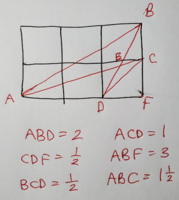cruxcriticorum
New member
- Joined
- Nov 9, 2020
- Messages
- 2
There are two lines that intersect inside the "outer" rectangle. Then you'll know vertices of all the triangles and can calculate areas of those. Please show us what you have tried and exactly where you are stuck. Please follow the rules of posting in this forum, as enunciated at: Please share your work/thoughts about this problem.
There are two lines that intersect inside the "outer" rectangle. Then you'll know vertices of all the triangles and can calculate areas of those.
Please show us what you have tried and exactly where you are stuck.
Please follow the rules of posting in this forum, as enunciated at:
Please share your work/thoughts about this problem.

There are two lines that intersect inside the "outer" rectangle. Then you'll know vertices of all the triangles and can calculate areas of those.
